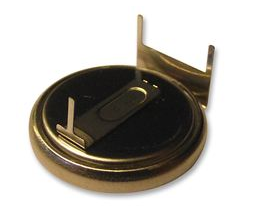This is just a short run-down of the thought process going into selecting alternative energy stores
Candidate requirements for an alternative store:
- Must be removable/replaceable OR rechargeable (and firmly fitted if removable/replaceable).
- Must aim to be low volume (so as to fit on the back/front of a blinky badge).
- Should not require superhuman skills to implement (SMD - yes if the pitch is >= 1mm, BGA - no!).
- If rechargeable, charging should not take so long as to put people off doing so (for the limited expected gain in pleasure of running the device again)
- Must allow the device to run for a reasonable duration. Requirements 4. and 5. are somewhat intertwined - if the charge time is low enough, I'd expect people would tolerate lower run-times.
- If removable, be harder/less attractive to put in mouth/swallow from a child's perspective, than a coin cell.
- If replaceable, be available to purchase from outlets the general public would use (such as AA cells).
- If rechargeable, be so from electrical supplies that are common in most homes (e.g. DC 5V phone charger)
I'm sure there are probably more requirements (other aspects of safety). From these, I assessed the following alternatives to lithium primary CR2032:
- Secondary lithium manganese dioxide coin cell. Low priority to investigate. Because when I looked into how you charge these:
- They take many, many hours to charge, which is the main reason I discounted them. PS, their max capacity is about 65mAh.
- You have to be really careful not to try and charge a lithium primary coin cell so only a tabbed-and-soldered-fixed-to-the-PCB arrangement would reduce this risk sufficiently, like these:
- Secondary lithium ion rechargeable (LIR) coin cells. Low priority to investigate. Adafruit used to sell these and you can still get them from main component distributors. You can get a 120mAh capacity but there aren't tabbed-and-soldered-fixed-to-the-PCB styles available, so I think the risk of one being removed from a coin cell holder and replaced with a primary lithium coin cell is too high with "general public" users. If they then tried to charge the primary version in your charging circuit, that would not be good.
- Primary lithium coin cells WITH sealing between the anode-cathode that increases their effective distance. High priority to investigate. @Ivan Stepaniuk suggested this initially and @B[] had the idea that some electrical tape could provide a quick means of testing the idea. Although this still doesn't significantly reduce the likelihood of swallowing a cell, it could reduce the damaging conversion of tissue fluid to highly caustic levels. The other disadvantage is that requiring some modification of a cell by the "general public" user may not be something we want to rely on, if we can find a better design solution. Despite these preconceived disadvantages, it's a high priority to test because we already have the coin cells available so it would be relatively easy to test the impact of this modification.
- Supercapacitors (perhaps with a boost circuit). High priority to investigate. Supercaps are not as energy dense as the coin cells but they have some possible advantages in the application of electronic badges:
- A constant current charging circuit could be simple and fast to recharge, countering the likely shorter run-times achieved with reasonably physically small caps.
- The ability to physically separate the energy store terminals is good. If a single 2.5-2.7V capacitor has pins 3.5mm apart, this is a good start. If our system wants two caps in series, we can make the distance between the 0V and 5V pins well over 20mm. If the circuit load layout allows, the min spacing between +V and 0V could be quite good.
- Supercaps can be easily soldered permanently to PCB and don't look like they're supposed to be removed to a "general public" user.
- I'm hoping to use some supercaps in the next version of #Yapolamp so would like to investigate them from a safety perspective.
- AAA primary or secondary cells with boost circuit. High priority to investigate. AAA cells have a nice opportunity to meet the form-factor demanded by small projects such as learn-to-solder badges. I'd like to think (although have little evidence) that the chances of an AAA cell being swallowed are less than coin cells. The most obvious downside is their 1.2-1.5V per cell maximum voltage (running down to ~0.9V when discharged). This won't run most electronics we're interested in, not even being enough to run a microcontroller at 1.8V or LEDs from 2V and up. However, voltages can be boosted to usable levels. I plan to investigate a boosted AAA cell. The battery holder for an AAA cell could add significant bulk relative to a badge, so that would have to be considered too. Perhaps something low-profile exists or could be made for this purpose.
Next time...
...maybe the modified CR2032. And perhaps a supercap experiment too.
 Simon Merrett
Simon Merrett
Discussions
Become a Hackaday.io Member
Create an account to leave a comment. Already have an account? Log In.